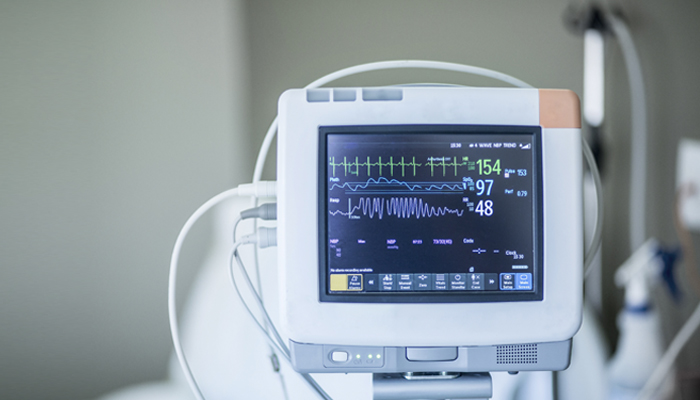HOW CAN WE HELP YOU? Call 1-800-TRY-CHOP
In This Section
Study Investigates Eliminating Monitor Overuse in Hospitals

CHOP researchers are looking to reduce the use of ineffective monitoring practices in certain circumstances and identify the best strategies to maintain these changes over time to ultimately improve outcomes for patient safety.
mccannn [at] chop.edu (By Nancy McCann)
In hospitals worldwide, patient monitors are essential equipment; their beeping alarms alerting healthcare providers to potentially harmful situations. But research has shown some forms of monitoring are overused and unnecessary — and can even threaten patient safety — by causing alarm fatigue for the attending physicians and nurses.
With a $5.3 million grant from the National Heart, Lung, and Blood Institute (NHLBI), researchers from Children’s Hospital of Philadelphia and the University of Pennsylvania are looking to reduce the use of ineffective monitoring practices in certain circumstances and identify the best strategies to maintain these changes over time to ultimately improve outcomes for patient safety. Christopher Bonafide, MD, MSCE, research director of Pediatric Hospital Medicine at CHOP, will lead the first-of-its-kind deimplementation trial titled Eliminating Monitor Overuse (EMO).
The research team, which includes co-PI Rinad Beidas, PhD, founding director of the Penn Implementation Science Center at the Leonard Davis Institute, is looking to identify effective strategies for deimplementing the overuse of pulse oximetry practices in infants experiencing bronchiolitis, an infectious lung disease. The primary outcome of this study, which is one of the largest projects focused on deimplementation within the implementation science field, centers on sustainability — or understanding how best to maintain these reductions in pulse oximetry practices over time.
“The EMO trial is a really exciting partnership between the relatively new field of implementation science and the new medical specialty of pediatric hospital medicine,” said Dr. Bonafide, who is also on faculty in Clinical Futures at CHOP and the Perelman School of Medicine at the University of Pennsylvania.
Continuous Pulse Oximetry Monitoring
Continuous pulse oximetry monitoring of oxygen saturation is a common intervention in bronchiolitis, which is a leading cause of infant hospitalization, resulting in over 100,000 hospitalizations and $1.7 billion hospital charges annually. Bronchiolitis exclusively affects children 2-years-old and younger. And it most often occurs during winter. But continuous pulse oximetry monitoring does not improve outcomes when it is used during periods of hospitalizations when the bronchiolitis patient has stabilized and no longer needs supplemental oxygen.
“When we continuously monitor children with bronchiolitis who are improving and are getting closer to the point of going home, it’s not only ineffective” Dr. Bonafide said, “but its overuse can prolong the hospital stay, increase risk of harm, and contribute to alarm fatigue, which threatens patient safety beyond the monitored patient.”
Deimplementaion Trial Design
Building on Dr. Bonafide’s previous studies that established the prevalence of overuse of continuous pulse oximetry and preliminary tests of deimplementation strategies, the research team is now looking for the best way to deimplement pulse oximetry and how best to sustain it.
“That’s the challenge,” Dr. Bonafide said, “those reductions are hard to sustain.”
Initially, the trial will include 40 U.S. hospitals in the Pediatric Research in Inpatient Settings (PRIS) Network, including CHOP. The study will take place over three winters. During the first winter, baseline pulse oximetry overuse will be measured.
In Winter 2, educational outreach and audit and feedback — frequently used approaches in the toolbox of implementation science — will be introduced as deimplementation strategies to all the hospitals. Half of the hospitals will also receive an electronic health record (EHR) strategy to provide decision support for healthcare providers. The EHR will prompt the doctors and nurses to consider eliminating continuous pulse oximetry monitoring in patients who are on the road to recovery.
Finally, in Winter 3 — considered the sustainability phase of the trial — the EHR strategy will remain in place as the only active deimplementation strategy for 50 percent of the hospitals, and pulse oximetry overuse will be measured again in all hospitals.
By withdrawing the education and audit and feedback interventions — which are expensive and personnel intensive to do — the researchers will look to see if deimplementation was better sustained in the arm that had the EHR support as opposed to the other arm that just did the education and audit and feedback over a single season during Winter 2.
“We’re not only trying to figure out what’s the best way to sustain the deimplementation, but also to carefully measure the extra cost and time and resources that are needed because every intervention we do has associated costs and personnel effort with it,” Dr. Bonafide said. “Deimplementing overused medical interventions is an essential step to maximize quality and minimize waste in our healthcare system.”